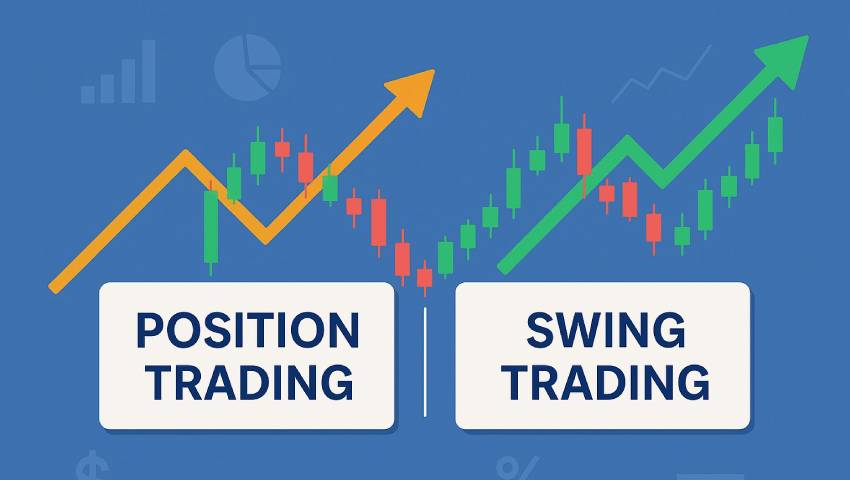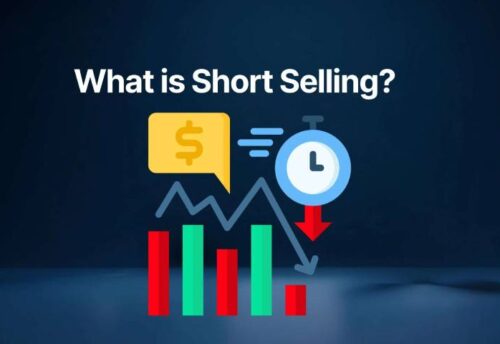
- 17/10/2025
- MyFinanceGyan
- 542 Views
- 6 Likes
- Share Market
Positional Trading vs Swing Trading vs Day Trading: Key Differences Explained
Trading in financial markets can be approached in several ways, depending on a trader’s goals, time commitment, and risk appetite. Among the most popular styles are positional trading, swing trading, and day trading.
While each of these approaches involves buying and selling in the market, they differ significantly in time horizons, risk levels, required skills, and strategies. Understanding these distinctions is essential for selecting the right approach that matches your personality and financial objectives.
This article explores the meaning, features, benefits, and challenges of each trading style and highlights the key differences between them.
What is Positional Trading?
- Positional trading is a long-term strategy where traders hold positions for weeks, months, or even years. Unlike passive investing, it is more active and relies on both technical analysis and fundamental analysis to capture sustained market trends.
Key Features:
- Long holding period: Trades last from several weeks to years.
- Trend-oriented: Focus on capturing large market moves.
- Low trade frequency: Fewer trades reduce costs and emotional stress.
- Fundamental integration: Consider company earnings, economic trends, and industry outlook.
- Lower time demand: Minimal need for daily monitoring.
Benefits:
- Lower stress due to fewer trades.
- Suitable for professionals with limited time.
- Potential for large gains by riding long-term trends.
- Reduced transaction costs compared to short-term trading.
Challenges:
- Requires patience to sit through volatility.
- Capital tied up for long durations.
- Overnight and macroeconomic risks can impact positions.
- Losses can be significant if stop-losses are ignored.
What is Swing Trading?
Swing trading is an intermediate strategy, sitting between positional and day trading. Swing traders aim to capture short- to medium-term price swings, holding trades from a few days to several weeks.
Key Features:
- Medium holding period: A few days to weeks.
- Technical focus: Heavy reliance on indicators like RSI, MACD, moving averages, and chart patterns.
- Moderate frequency: More trades than positional, fewer than day trading.
- Two-way trading: Profits possible in bullish or bearish trends.
- Market monitoring: Regular attention required, but not full-time.
Benefits:
- More profit opportunities than positional trading.
- Less capital locked compared to long-term trades.
- Suitable for part-time traders with market awareness.
- Balance between activity and exposure.
Challenges:
- Requires strong technical analysis skills.
- Exposed to overnight risks and market gaps.
- Moderate stress due to position monitoring.
- Timely exits are critical to protect profits.
What is Day Trading?
Day trading is the most active trading style, where all positions are opened and closed within the same day. Day traders aim to profit from intraday volatility and execute multiple trades daily.
Key Features:
- Very short holding period: Minutes to hours, no overnight positions.
- High frequency: Multiple trades daily.
- Technical intensity: Use of charts, real-time data, and trading platforms.
- No overnight risk: Positions squared off by market close.
- Full-time focus: Requires constant monitoring during trading hours.
Benefits:
- Daily profit potential.
- No overnight exposure.
- Multiple opportunities across stocks and indices.
- Easy to enter/exit in highly liquid assets.
Challenges:
- Highly stressful and emotionally demanding.
- Significant time and attention required.
- Higher transaction costs due to frequent trading.
- Steep learning curve with risk of large losses.
Comparing Time Frames:
- Longer holding periods → Lower activity but higher exposure to overnight risks.
- Shorter holding periods → Lower overnight risk but demand more active involvement.
Risk and Reward Profiles:
- Positional Trading: Lower short-term risk, but exposure to big market events. Potential for large profits over time.
- Swing Trading: Moderate risk from overnight positions; medium-term gains achieved faster.
- Day Trading: High risk due to fast-paced trades and leverage; rewards are smaller but frequent.
Capital Needs and Costs:
- Positional: Requires larger capital for long-term positions, plus overnight margin.
- Swing: Needs flexible capital for days/weeks of exposure.
- Day Trading: High capital requirement to meet intraday margin and cover high transaction costs.
Skill Set and Psychology:
- Positional Traders: Strong analytical and emotional discipline to withstand noise.
- Swing Traders: Technical expertise and balanced risk management.
- Day Traders: Quick decision-making, stress handling, and advanced trading skills.
Which Trading Style is Right for You?
Your choice depends on:
- Time availability – Full-time vs part-time vs passive.
- Personality – Patience for long-term vs preference for quick results.
- Financial goals – Wealth creation vs regular income.
- Risk appetite – Conservative vs aggressive.
- Knowledge & tools – Comfort with trading platforms and strategies.
Conclusion:
Positional trading, swing trading, and day trading each offer unique opportunities and challenges. The key is to align your strategy with your goals, lifestyle, and risk tolerance.
- Choose positional trading if you prefer patience and long-term trends.
- Opt for swing trading if you want balance between activity and flexibility.
- Consider day trading only if you can commit full-time with high discipline.
By understanding the differences and adopting the style that best fits your personality, you can enhance your chances of trading success and achieve your financial aspirations.
Disclaimer: The views expressed in this blog are personal and for educational purposes only. They are not intended as financial advice or product recommendations.



